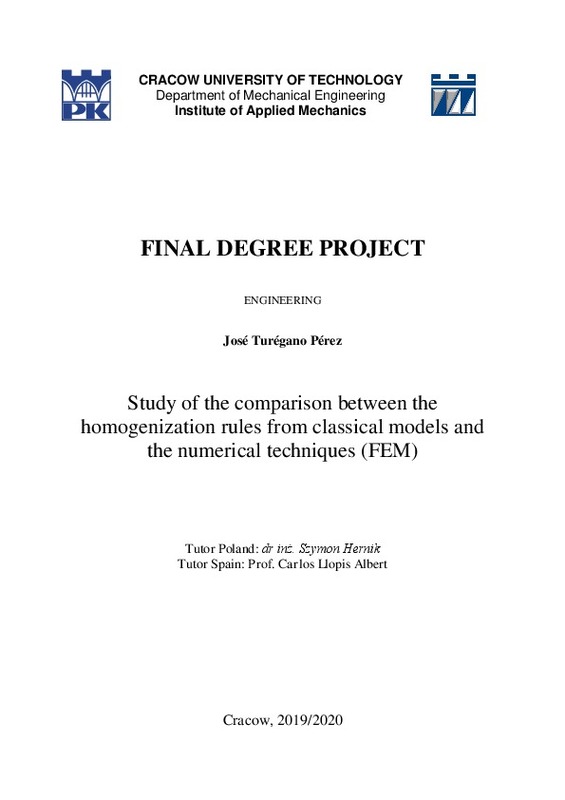JavaScript is disabled for your browser. Some features of this site may not work without it.
Buscar en RiuNet
Listar
Mi cuenta
Estadísticas
Ayuda RiuNet
Admin. UPV
Estudio de la comparación entre las reglas de homogeneización de modelos clásicos y las técnicas numéricas (FEM)
Mostrar el registro sencillo del ítem
Ficheros en el ítem
| dc.contributor.advisor | Llopis Albert, Carlos
|
es_ES |
| dc.contributor.advisor | Hernik, Szymon
|
es_ES |
| dc.contributor.author | Turégano Pérez, José
|
es_ES |
| dc.date.accessioned | 2020-12-09T12:52:05Z | |
| dc.date.available | 2020-12-09T12:52:05Z | |
| dc.date.created | 2020-07-14 | |
| dc.date.issued | 2020-12-09 | es_ES |
| dc.identifier.uri | http://hdl.handle.net/10251/156592 | |
| dc.description.abstract | [EN] The analysis of structural behaviour of materials is topic that has developed through time, but nowadays it has taken more relevance with the need of new materials with better qualities to comply the advance of new technologies. Traditionally, the calculations of composites were made with the classical models, in which one uses the homogenization and location techniques to provide the response of a structure, based on the properties or response of the structure’s constituents [2]. Nevertheless, with the advance in numerical techniques based on computational methods, there has been created new tools to make these calculations easier and faster. The focus of the project consists on proving the accuracy of these new techniques, specifically the tool Material Designer, in comparison with the classical techniques that engineers have been using for years. To do so, the project begins with a description of four classical methods. For which each one is explained the hypothesis behind the model and the equations deduced by the author. Moreover, for each method there is the application of the practical problem in question on this project. Additionally, the project shows the performance of the Material Designer software and the result of the analysis. Finally, the project concludes with a comparison of the results and a conclusion that sums up the whole project based on the results obtained. | es_ES |
| dc.description.abstract | [ES] El proyecto consiste en la comparación entre los resultados obtenidos con los modelos clásicos de homogeneización y la herramienta de Ansys, Material Designer. La comparación se realizará con una viga metálica reforzada por varillas de cerámica. Los modelos clásicos que se estudiarán son: método de Voigt y Reuss, Reglas de Hashin-Strickann y sus límites, método Eshelby y método Mori-Tanaka. La finalidad del proyecto es determinar la fiabilidad de las técnicas numéricas, en este caso el uso del método de los elementos finitos (FEM) usado con el programa Ansys, frente a los modelos teóricos. | es_ES |
| dc.format.extent | 21 | es_ES |
| dc.language | Inglés | es_ES |
| dc.publisher | Universitat Politècnica de València | es_ES |
| dc.rights | Reserva de todos los derechos | es_ES |
| dc.subject | Homogeneización | es_ES |
| dc.subject | Ansys | es_ES |
| dc.subject | Comparación | es_ES |
| dc.subject | Fiabilidad | es_ES |
| dc.subject | Voigt | es_ES |
| dc.subject | Reuss | es_ES |
| dc.subject | Hashin-Strickann | es_ES |
| dc.subject | Eshelby | es_ES |
| dc.subject | Mori-Tanaka | es_ES |
| dc.subject.classification | INGENIERIA MECANICA | es_ES |
| dc.subject.other | Grado en Ingeniería en Tecnologías Industriales-Grau en Enginyeria en Tecnologies Industrials | es_ES |
| dc.title | Estudio de la comparación entre las reglas de homogeneización de modelos clásicos y las técnicas numéricas (FEM) | es_ES |
| dc.type | Proyecto/Trabajo fin de carrera/grado | es_ES |
| dc.rights.accessRights | Abierto | es_ES |
| dc.contributor.affiliation | Universitat Politècnica de València. Departamento de Ingeniería Mecánica y de Materiales - Departament d'Enginyeria Mecànica i de Materials | es_ES |
| dc.contributor.affiliation | Universitat Politècnica de València. Escuela Técnica Superior de Ingenieros Industriales - Escola Tècnica Superior d'Enginyers Industrials | es_ES |
| dc.description.bibliographicCitation | Turégano Pérez, J. (2020). Estudio de la comparación entre las reglas de homogeneización de modelos clásicos y las técnicas numéricas (FEM). http://hdl.handle.net/10251/156592 | es_ES |
| dc.description.accrualMethod | TFGM | es_ES |
| dc.relation.pasarela | TFGM\131580 | es_ES |
Este ítem aparece en la(s) siguiente(s) colección(ones)
-
ETSII - Trabajos académicos [10404]
Escuela Técnica Superior de Ingenieros Industriales






